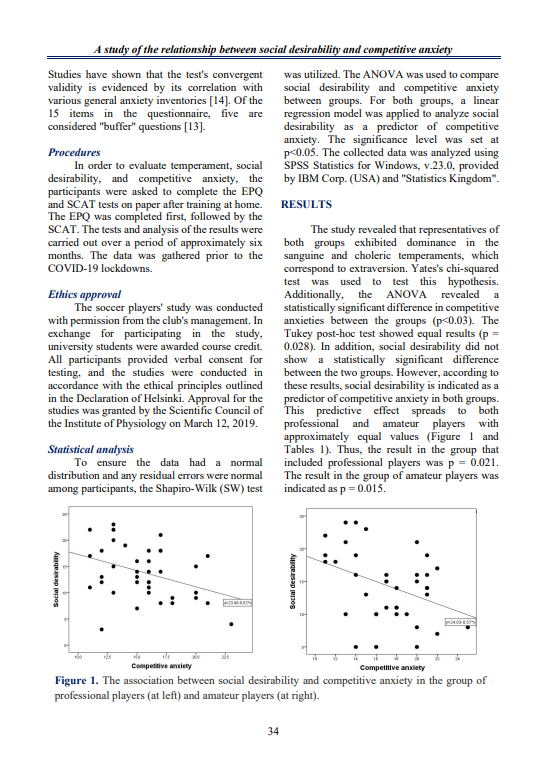Abstract
This study investigated temperament, social desirability, and anxiety in professional and amateur male soccer players. The goal of this study was to compare social desirability among professional and amateur soccer players and its association with temperament and competitive anxiety. Participants (n = 78) were equally divided into professional and amateur players. The EPQ (Eysenck Personality Questionnaire) was used to assess the participants' temperament and social desirability. Additionally, the SCAT (Sport Competition Anxiety Test) was completed by the participants to reveal their anxiety levels. The temperament types were compared using Yates's correction for continuity, while a linear regression model was used to determine if social desirability could predict anxiety levels among the players. The study found that both groups had dominant sanguine and choleric temperaments, which corresponded to extraversion. The ANOVA showed a statistically significant difference in competitive anxieties between the two groups (p<0.03). The results of the regression analysis revealed a statistically significant relationship with a negative slope between social desirability and competitive anxiety in professional players (p<0.021) and amateur players (p<0.015). The data illustrate that the professional and amateur levels of soccer players are not dependent on the predictive effect of social desirability on competitive anxiety; however, it was only associated with constant sports activities. Thus, it was revealed that as the level of social desirability among soccer players increases, the level of their competitive anxiety decreases.
References
Ahmad S, Safdar F. Goal Orientation, Motivation, and Competitive Anxiety in Players of Domestic Cricket in Pakistan. Pakist. J. Psychol. Res. 2020:87-105. https://doi.org/10.33824/PJPR.2020.35.1.6
Allen MS, Greenlees I, Jones M. Personality in sport: A comprehensive review. Int. Review Sport Exerc. Psych. 2013;6(1):184-208. https://doi.org/10.1080/1750984X.2013.769614
Davies MF, French CC, Keogh E. Self-deceptive enhancement and impression management correlates of EPQ-R dimensions. J. Psychol. 1998;132(4): 401-406. https://doi.org/10.1080/00223989809599274
Eagleton JR, McKelvie SJ, De Man A. Extraversion and neuroticism in team sport participants, individual sport participants, and nonparticipants. Percept. Motor Skills. 2007;105(1):265-75. https://doi.org/10.2466%2Fpms.105.1.265-275
Elman W, McKelvie S. Narcissism in football players: Stereotype or reality. Athlet. Insight. 2003;5(1):38-46.
Eysenck SB, Eysenck HJ, Barrett P. A revised version of the psychoticism scale. Pers. Individ. Differ. 1985;6(1):21-29. https://doi.org/10.1016/0191-8869(85)90026-1
Eysenck HJ, Nias DKB, Cox DN. Sport and personality. Advan. Behav. Res. Ther. 1982;4:1-56. https://doi.org/10.1016/0146-6402(82)90004-2
Francis LJ. The dual nature of the EPQ lie scale among college students in England. Pers. Individ. Differ. 1991;12(12):1255-1260. https://doi.org/10.1016/0191-8869(91)90197-J
Franklin ZC, Smith NC, Holmes PS. Anxiety symptom interpretation and performance expectations in high-anxious, low-anxious, defensive high-anxious and repressor individuals. Pers. Individ. Differ. 2015;77:27-32. https://doi.org/10.1016/j.paid.2014.12.040
Feichtinger P, Höner O. Psychological diagnostics in the talent development program of the German Football Association: Psychometric properties of an Internet-based test battery. Sportwissenschaft. 2014;44(4): 203-213. https://doi.org/10.1007/s12662-014-0341-0
Grossbard JR, Cumming SP, Standage M, Smith RE, Smoll FL. Social desirability and relations between goal orientations and competitive trait anxiety in young athletes. Psychol. Sport Exerc. 2007;8(4):491-505. https://doi.org/10.1016/j.psychsport.2006.07.009
Han DH, Kim JH, Lee YS, Bae SJ, Bae SJ, Kim HJ, et al. Influence of temperament and anxiety on athletic performance. J. Sports Sci. Med. 2006;5(3): 381-389.
Iwuagwu TE, Umeifekwem JE, Igwe SN, Oforka OK, Udeh OP. Profile of sport competition anxiety trait and psychological coping skills among secondary school athletes in Enugu State, South East Nigeria. Balt. J. Health Phys. Activ. 2021;Suppl(2):75-87. https://doi.org/10.29359/BJHPA.2021.Suppl.2.08
Lavallee D, Kremer J, Moran A, Williams M. Sport Psychology: Contemporary Themes. London: Palgrave Macmillan. 2012.
Martens R. Sport Competition Anxiety Test; Human Kinetics: Champaign, IL. 1977. https://doi.org/10.1037/t27556-000
Martens R, Burton D, Vealey RS, Bump LA, Smith DE. Development and validation of the Competitive State Anxiety Inventory-2. In Martens, R. Vealey R.S. Burton D. (eds.) Competitive Anxiety in Sport. Human Kinetics: Champaign, IL. 1990. pp. 127-140.
Moore LJ, Vine SJ, Freeman P, Wilson MR. Quiet eye training promotes challenge appraisals and aids performance under elevated anxiety. Int. J. Sport Exerc. Psychol. 2013;11(2):169-183. https://doi.org/10.1080/1612197X.2013.773688
Motl RW, McAuley E, DiStefano C. Is social desirability associated with self-reported physical activity? Prevent. Med. 2005;40(6): 735-739. https://doi.org/10.1016/j.ypmed.2004.09.016
Ryska TA. Coping styles and response distortion on self-report inventories among high school athletes. J. Psychol. 1993;127(4): 409-418. https://doi.org/10.1080/00223980.1993.9915576
Smith D, Driver S, Lafferty M, Burrell C, Devonport T. Social desirability bias and direction modified competitive state anxiety inventory–2. Percept. Motor Skills. 2002; 95(3):945-952. https://doi.org/10.2466%2Fpms.2002.95.3.945
Smith RE, Smoll FL, Wiechman SA. Measurement of trait anxiety in sport. In Duda J.L. (eds.) Advancements in Sport and Exercise Psychology measurement. Morgantown, WV: Fitness Information Technology. 1998. pp. 105-127.
Smoller JW, Block SR, Young MM. Genetics of anxiety disorders: the complex road from DSM to DNA. Depress. Anxiety. 2009;26(11):965-975. https://doi.org/10.1002/da.20623
Sultanov MB, Ismailova KY. EEG rhythms in prefrontal cortex as predictors of anxiety among youth soccer players. Translat. Sports Med. 2019;2(4):203-208. https://doi.org/10.1002/tsm2.72
Sultanov MB. EEG Correlates of Eysenck's Personality Traits in Young Male Athletes. T. State Uni. J. 2020;454:209-213. https://doi.org/10.17223/15617793/454/25
Sultanov MB. Psychological Characteristics of Professional Soccer Players and their Comparison with Amateur Players. Momona Ethiop. J. Sci. 2023;15(1): 105-115. https://doi.org/10.4314/mejs.v15i1.8
Stebbings J, Taylor IM, Spray CM. The relationship between psychological well-and ill-being, and perceived autonomy supportive and controlling interpersonal styles: A longitudinal study of sport coaches. Psychol. Sport Exerc. 2015;19:42-49. https://doi.org/10.1016/j.psychsport.2015.02.002
Strelay J. The concepts of arousal and arousability as used in temperaments studies. In Bates J.E. and Wachs T.D. (eds.) Temperament: Individual differences at the interface of biology and behavior. APA. 1994. pp. 117-141. https://doi.org/10.1037/10149-000
Verburgh L, Scherder EJA, van Lange PAM, Oosterlaan J. Executive functioning in highly talented soccer players. PLoS One. 2014;9(3):e91254. https://doi.org/10.1371/journal.pone.0091254
Tavakol M, Dennick R. Making sense of Cronbach's alpha. Int. J. Med. Educ. 2011;2: 53-55. https://doi.org/10.5116%2Fijme.4dfb.8dfd
Wilson M, Smith NC, Holmes PS. The role of effort in influencing the effect of anxiety on performance: Testing the conflicting predictions of processing efficiency theory and the conscious processing hypothesis. Br. J. Psychol. 2007;98:411-428. https://doi.org/10.1348/000712606X133047
Wold B, Duda JL, Balaguer I, Smith ORF, Ommundsen Y, Hall HK, et al. Comparing self-reported leisure-time physical activity, subjective health, and life satisfaction among youth soccer players and adolescents in a reference sample. Int. J. Sport Exerc. Psychol. 2013;11(4):328-340. https://doi.org/10.1080/1612197X.2013.830433

This work is licensed under a Creative Commons Attribution 4.0 International License.
Copyright (c) 2023 Azerbaijan Journal of Physiology





